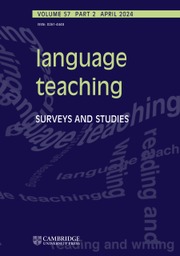Crossref Citations
This article has been cited by the following publications. This list is generated based on data provided by
Crossref.
Danan, Martine
2010.
Dubbing projects for the language learner: a framework for integrating audiovisual translation into task-based instruction.
Computer Assisted Language Learning,
Vol. 23,
Issue. 5,
p.
441.
Young A Ryu
2010.
The theoretical validity and educational basis of using movies in language education..
STEM Journal,
Vol. 11,
Issue. 1,
p.
103.
Vanderplank, Robert
2011.
Evaluating Computer-assisted Language Learning: An Integrated Approach to Effectiveness Research.
System,
Vol. 39,
Issue. 4,
p.
569.
Sockett, Geoffrey
2011.
From the cultural hegemony of English to online informal learning: Cluster frequency as an indicator of relevance in authentic documents.
ASp,
Vol. 60,
Issue. ,
p.
5.
Loewen, Shawn
and
Reinders, Hayo
2011.
Key Concepts in Second Language Acquisition.
p.
1.
Develotte, Christine
2011.
Réflexions sur les changements induits par le numérique dans l'enseignement et l'apprentissage des langues.
Éla. Études de linguistique appliquée,
Vol. n°160,
Issue. 4,
p.
445.
Bibbee, Evan
Smidt, Esther
and
Lazar, Vladimir
2012.
Computer-Enhanced and Mobile-Assisted Language Learning.
p.
81.
Caimi, Annamaria
2013.
Handbook of Translation Studies.
Vol. 4,
Issue. ,
p.
167.
Wang, Dongshuo
Zou, Bin
and
Xing, Minjie
2013.
Explorations of Language Teaching and Learning with Computational Assistance.
p.
212.
Montero Perez, Maribel
Van Den Noortgate, Wim
and
Desmet, Piet
2013.
Captioned video for L2 listening and vocabulary learning: A meta-analysis.
System,
Vol. 41,
Issue. 3,
p.
720.
Winke, Paula
Gass, Susan
and
Sydorenko, Tetyana
2013.
Factors Influencing the Use of Captions by Foreign Language Learners: An Eye‐Tracking Study.
The Modern Language Journal,
Vol. 97,
Issue. 1,
p.
254.
Cardenas-Claros, Monica Stella
and
Gruba, Paul A.
2013.
Decoding the “CoDe”: a framework for conceptualizing and designing help options in computer-based second language listening.
ReCALL,
Vol. 25,
Issue. 2,
p.
250.
Wagner, Elvis
2013.
The Companion to Language Assessment.
p.
47.
Moon Eun-Joo
and
Jiyeo Yun
2014.
Learner Perceptions on the Effects of Different Types of Subtitles and Explanation Methods in the EFL Classroom Using Films.
STEM Journal,
Vol. 15,
Issue. 3,
p.
21.
Talaván, Noa
and
Rodríguez-Arancón, Pilar
2014.
The use of reverse subtitling as an online collaborative language learning tool.
The Interpreter and Translator Trainer,
Vol. 8,
Issue. 1,
p.
84.
Kruger, Jan-Louis
and
Steyn, Faans
2014.
Subtitles and Eye Tracking: Reading and Performance.
Reading Research Quarterly,
Vol. 49,
Issue. 1,
p.
105.
Cárdenas-Claros, Mónica Stella
2015.
Design considerations of help options in computer-based L2 listening materials informed by participatory design.
Computer Assisted Language Learning,
Vol. 28,
Issue. 5,
p.
429.
Leveridge, Aubrey Neil
2015.
Intelligent Design of Interactive Multimedia Listening Software.
p.
75.
Çetin, Yakup
2015.
The Impact of Sexual Media on Second Language Vocabulary Retrieval.
Journal of Religion and Health,
Vol. 54,
Issue. 6,
p.
2412.
Karatay, Yasin
2015.
An investigation of a multimedia language lab project in Turkish state universities.
p.
288.

